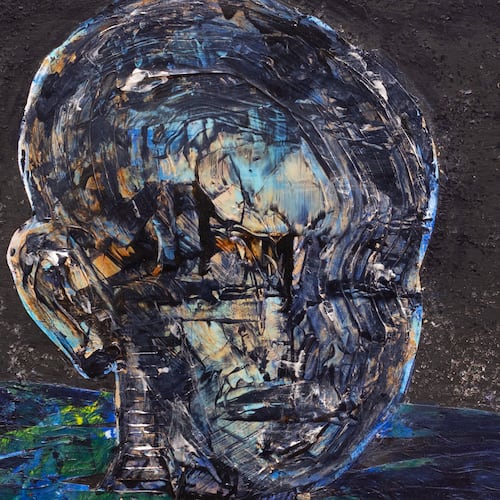Georgia-born and Brooklyn-based painter Whitney Wood Bailey doesn’t always deliver in her solo show “You’ll Never Make This Again” at the Westside gallery Hathaway. But when she does hit her groove the results are cosmic eye candy: a glimpse into a trippy infinity and the morphing, mesmeric, protoplasmic capabilities of paint when applied to canvas and paper.
As a general rule in “You’ll Never Make This Again,” bigger is not always better in Bailey’s work. Some of the best pieces in the show are smaller works on paper framed behind glass, the paper so sodden with paint it bends and warps with the weight. Like looking into a snow globe or kaleidoscope, there are worlds inside those works, bizarre fantasias of eyeballs and tentacles, teeth, trees and replicating cells, a universe in flux that you could see as granular or macro, depending upon your state of mind.
Her collisions of pattern and free-form shape and color suggest the cells coursing through our bloodstream. But those mad whirls of shape can also resemble landscapes, ribbons of highway, strange archipelagos, constellations glowing white-hot in the sky. You sense nature's flux but also humankind's urge to make order as two forces at play in her paintings. As her artist's statement for the show declaims "an intersection of faith and reason, and instinct and intellect," are contradictions that Bailey's paintings address.
MORE ON AJC.COM: Atlanta photo exhibit documents black Southern cowboys
A work like “Hold You” (2019) in oil and mixed media on paper is flat-out fun to look at. Its gooey, morphing, spurting tendrils of paint laid over more orderly grids and patterns suggest the love child of Gustav Klimt and Wangechi Mutu. The work is a reminder of the sensual, purely visual pleasure of abstraction. Epic in size but more seductive in its effects, “Paracosm” (2019) takes its name from the imaginative, fictional worlds human beings often create in childhood. Many writers, from the Bronte sisters to Robert Louis Stevenson and C.S. Lewis went on to establish remarkable literary careers — and imaginative universes — after childhoods spent creating paracosms. And artists also spend their lives continuing to create astounding, inventive worlds, Bailey’s invocation of the term suggests.
In Bailey’s hands “Paracosm” is an otherworldly universe full of sensuous natural forms, like a colorful fish tank filled with plants shifting with the currents and dozens of tiny creatures floating by.
Bailey gets into trouble when she follows a mantra of “go big or go home.” Paintings like “Tree of Life” at 84 by 72 inches with its central blue tree and a psychedelic landscape unfurling around it, feel overloaded and busy in a less meaningful way. It is in her sparer, cleaner work undulating like a python or laid out like a cityscape on a clean white surface that leaves your eyes room to roam, but also rest. By the same token “The Joy Fields 2” (2019) is an assaultive explosion of acidic, neon corals, fleshy apricots and cotton candy pinks that feels less like a glimpse into a hidden world and more like an artist who can become dependent on the sheer spectacle of color for impact.
In the past, Bailey has often tended to paint in tight, controlled, cellular clusters. It’s nice to see her loosen up here, and maybe — at least aesthetically — let go. Perhaps, as the paintings themselves indicate, Bailey is just engaged in the artist’s purest pursuit: to change and grow, to morph from one thing into another, which is always a worthwhile pursuit.
ART REVIEW
“You’ll Never Make This Again: Whitney Wood Bailey”
Through Jan. 11. 10 a.m.-5 p.m.Tuesdays-Saturdays. Free. Hathaway Gallery, 887 Howell Mill Road, NW, Suite 200, 470-428-2061, hathawaygallery.com.
Bottom line: Many of her works trade visual impact for spectacle and size but this painter still manages to delight at times.
About the Author
Keep Reading
The Latest
Featured





